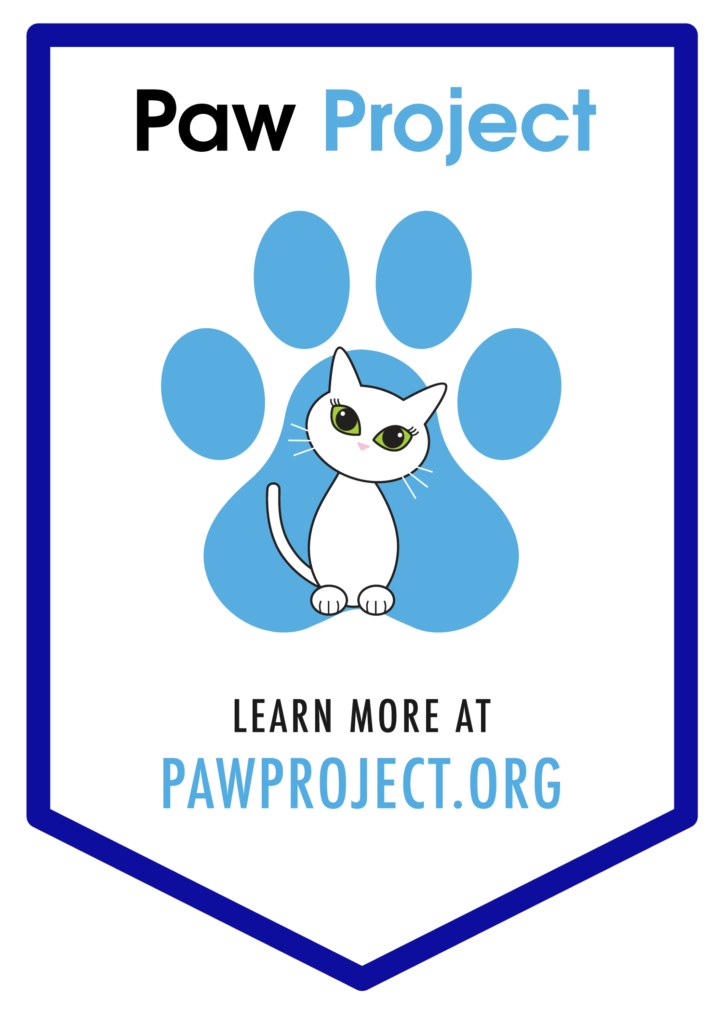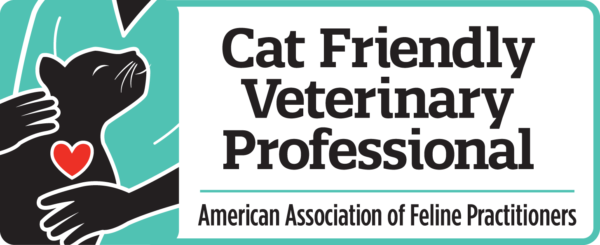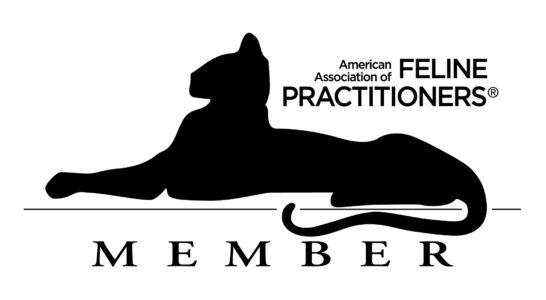What is constipation?
Constipation can be defined as an abnormal accumulation of feces resulting in difficult bowel movements. This may result in reduced frequency or absence of defecation. The feces are retained in the large intestine or colon. Since one of the functions of the colon is water absorption, the retained feces become hard and dry, which makes fecal passage even more difficult.
Constipated cats strain in an attempt to defecate resulting in abdominal pain. Some constipated cats may pass small amounts of liquid feces or blood. They will often vomit during and/or after straining to defecate, whether or not feces are produced. They will also often lose their appetite and/or become lethargic when they are constipated.
Many constipated cats will defecate outside the box and often it is unintentional. They may start out in the litter box trying to defecate but little or nothing comes out until they start to walk away. The physical activity of walking helps some feces fall out to the ground. Alternatively, they may defecate wherever they are if they get the urge, which can be very frequently since their colon is so full and a litter box may be too far away. Finally, they may start to associate the pain of straining and difficult defecation with the litter box and develop an aversion to using it because of that.
Painful cats, just like people, may act in ways we would refer to as cranky, easily agitated, or aggressive towards people, especially children, and/or other animals. Pain or discomfort from any source often causes cats to act out of their ordinary routine. They may hide, be less social, have different eating habits, and/or different elimination habits as described above. Sick or painful cats are not being spiteful or acting out of anger, just out of distress. It is their natural instinct to behave this way. In the wild, a painful or sick cat is a weak cat and a weak cat is a potential victim. Changing their normal routine and/or demeanor may ward off a potential predator. So you see, what seems abnormal to the untrained human eye is actually normal to the feline survival instinct.
What causes constipation?
Factors associated with causing constipation include:
1. Hairballs, especially in long-haired cats.
2. Ingestion of foreign bodies.
3. Obstruction caused by tumors, strictures or masses compressing or blocking the large intestine.
4. Pelvic injuries resulting in a narrowed pelvic canal.
5. Damage of the nerves, which cause the colon to contract. This may develop after trauma or may be part of a more generalized neurological disease.
6. Dehydration from other metabolic disease conditions.
7. In some cases, there is no underlying cause.
Constipation is a condition seen most commonly in middle-aged and older cats. In the vast majority of cats, there is no underlying cause.
Anal Glands
In addition to constipation, some cats may develop enlarged or impacted anal glands that can also make it difficult for feces to pass through the anus. Anal glands are sacs that are located under the skin, at about 4 and 8 o’clock on either side of the anus. They empty with normal defecation. These anal sacs are filled with a foul smelling liquid and a few drops are usually excreted to mark their stool during the process of defecating. For some cats, the liquid within these sacs can become dry and cakey, making it difficult to be excreted. Sometimes anal glands can become infected and even rupture. For cats that are straining to defecate, the anal sacs should be evaluated and emptied to ensure that feces can comfortably pass. Full anal sacs can cause discomfort, be itchy, and contribute to defecation outside of the litter box (and the commonly seen “scooting” behavior).
What is Megacolon?
This term refers to a dilated and weak colon that has lost the ability to contract and push feces out the anus. Megacolon may be seen as a primary problem or following long-term constipation. When the colon becomes distended with fecal material over a prolonged period of time, its ability to contract may be reduced or lost resulting in Megacolon.
How are constipation and Megacolon diagnosed?
In most cases, a diagnosis of constipation can be made on the basis of the cat’s clinical signs. Affected cats usually strain unsuccessfully to defecate and may cry in pain. Any feces passed are hard and dry. Often cats will leave small amounts of hard, dry feces outside the litter box as they may continue to strain and pass feces as they walk around your home. Or they make think they are finished in the litter box and the physical activity of walking helps remove any fecal balls left near the anus. The cat may also show signs of lethargy, reluctance to eat and vomiting.
X-rays are also the primary test for the diagnosis of Megacolon. Bloodwork is also helpful in diagnosing any underlying causes of dehydration, such as kidney disease, which can predispose the body to constipation.
How can constipation and Megacolon be treated?
Initial treatment of a cat with constipation may involve administration of enemas and manual extraction of feces by a veterinarian. The latter may necessitate anesthesia. Treatment of dehydration with subcutaneous fluids may also be needed in cats that have become dehydrated. If the constipation recurs or becomes a long-term problem, continuous therapy may be needed to prevent recurrence.
Most cats need a stool softener twice a day. A wide variety of treatments are available to soften the feces and promote regular bowel movements:
Increasing the amount of canned food intake helps to soften feces. Your veterinarian can help you decide which variety of food would be best for your cat’s overall health.
Increasing water intake by adding water bowls, drinking fountains, or flavoring the water with chicken broth or tuna water to encourage drinking may be recommended. Always provide a traditional water bowl in case your cat does not prefer the flavored water.
Subcutaneous fluid therapy at home may also be recommended on a regular basis to maintain hydration.
Lubricating laxatives or stool softeners for example, hairball remedies such as Laxatone*, Laxaire*, Petromalt*, or even plain Vaseline* (petroleum jelly is the main ingredient in the previously listed products) may also be used in mildly affected cats.
*It is important to note that these products should not be given with anyy medications as their job is to bind and escort out which lessens the absorption of pill and liquid medications!*
Small amounts of dairy products every day can help soften stool since most cats are lactose intolerant. Examples of dairy that many cats enjoy: cream, half and half, sour cream, ice cream, whipped cream cheese, yogurt, and milk. Many people consume non dairy or lactose free milk. These will not help your cat, so be sure you are offering true dairy products.
A prescription stool softener, Lactulose, may be recommended.
Miralax is an over the counter, flavorless powder that can be easily mixed into some canned food. Always consult with your veterinarian regarding what dosing range is safe and appropriate for your cat!
Those more severely affected may need motility drugs that stimulate contraction of the colon. The doses of all of these drugs and/or supplements may need to be altered to produce the desired effect.
*IMPORTANT* If your cat is already constipated and exhibiting symptoms of straining, yowling, and vomiting, the above listed products WILL NOT soften the hardened stool already impacting your cat’s GI tract. You should see your veterinarian immediately!
Ideally, cats should defecate at least once every other day. Over a period of time, resistance to treatment can occur, necessitating an increase in the drug dosage or a change in therapy. No changes to the treatment protocol should be made without consulting your veterinarian. Even with chronic medical treatment, every once in a while cats may need to see the veterinarian for enemas and/or manual evacuation (This is when the veterinarian manually removes feces from the rectum).
In long-haired cats, regular grooming such as combing, sanitary and stomach shaves and lioncuts are helpful at reducing the potential for high volumes of fur being ingested. Hairball removal agents listed above and hairball diets may also help reduce the likelihood of hairballs causing constipation or GI obstruction.
It is important to ensure that there is always access to enough large, clean litter boxes dispersed throughout the home so that frequent defecation is encouraged.
If Megacolon develops or if the constipation is severe and medical treatment is unsuccessful, surgery may be recommended but this is uncommon. Surgical treatment involves removal of most of the colon called a partial or sub-total Colectomy.
What is the long-term outlook for a cat with this problem?
As long as a constipated cat receives its daily medications as prescribed by the veterinarian, cats do well. The long-term outlook varies according to the cause of the constipation; however, the vast majority of cats can be adequately managed without surgery and resume normal, healthy lives. It is imperative that you stay in close communication with your veterinarian about what treatments are successful and which are failing so that you can continue to be guided on further steps to ensure the best possible management of the problem.






